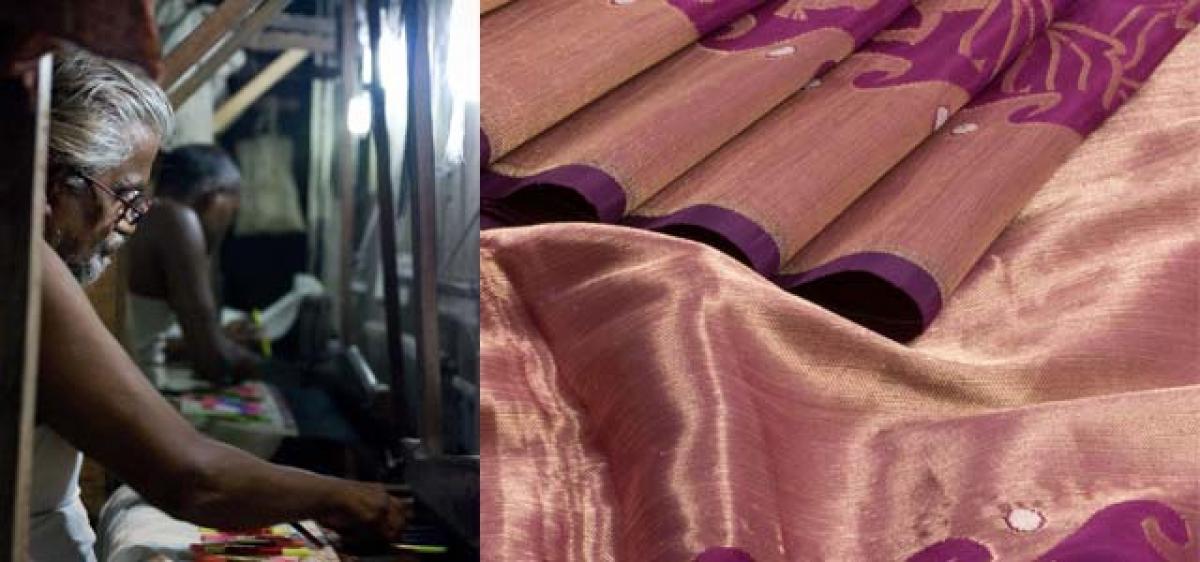Live
- Disinformation major challenge, says Pak army chief after drawing flak on social media
- Digital media platforms must curb fake news, safeguard democracy: Ashwini Vaishnaw
- BJP wants to form govt in Jharkhand to loot its natural resources: Kharge
- Germany's healthcare sector hit by skilled labour shortages
- Mallikarjun Kharge predicts INDIA bloc’s victory in Jharkhand, promises to fulfill seven guarantees
- Israel renews attacks on Beirut's southern suburbs after evacuation call
- Uzbekistan continues gas accounting, control to ensure stable supply
- Transform Anganwadi Centers into Hubs of Quality Nutrition and Education: Collector Badavath Santosh
- 'Never in history has Maharashtra slid so badly': Chidambaram faults BJP on state's economic condition
- Farmers Must Registered Livestock Details - Veterinary Doctors
Just In

Remember Prime Minister Narendra Modi’s promise of bringing light into the lives of Varanasi’s weavers who are known for their finesse in churning out six-yard magic called Banarasi sari? During the 2014 General Elections, Modi, who contested from the ancient temple town as Lok Sabha MP, made an emotive promise to revive Banarasi silk and related trade.
Modi’s promise to revive silk industry could not change fortunes of 40k weavers community
Hyderabad: Remember Prime Minister Narendra Modi’s promise of bringing light into the lives of Varanasi’s weavers who are known for their finesse in churning out six-yard magic called Banarasi sari? During the 2014 General Elections, Modi, who contested from the ancient temple town as Lok Sabha MP, made an emotive promise to revive Banarasi silk and related trade.
About six months after his stupendous victory, the Gujarati strongman went back to his Varanasi constituency in November 2014 and announced a Rs 2,375-crore package to help textile sector and thereby weavers there. However, the Prime Minister did not stop at that point.
He also made a statement on the market potential of Banarasi saris. “Every mother has a dream to gift at least one Benarasi sari to her daughter in marriage and about 20 crore marriages will take place in the country in next few years. It needs no marketing. You have to just tap the huge market already available across the country,” Modi was quoted as saying after announcing the special package.
But surprisingly, Modi’s repeated promise, revival package and emotive appeal did not make much of a difference to 40,000-odd weavers who make their sustenance on the 2,500-old craftsmanship of weaving silk saris in the temple town and surrounding areas. Over 5 lakh people work in UP’s silk industry.
Local experts and people in the know of this segment say the world famous handloom craft of weaving Banarasi silk magic is slowly inching towards extinction as weavers, weighed down by falling demand and increasing competition from ‘fake handloom’ products from domestic power looms as well as China, are looking at other avenues to eke out a living. Some weavers are also turning labourers as there is no way they can depend on the weaving, they add. Same is the case with over 2,000 traders many of whom are moving away from the famous silk.
“Lured and influenced by western fashion trends, younger Indian women have moved away from saris. It has led to steep fall in demand for saris, adversely affecting the livelihood of the weaving community across the country. This problem is more acute in Varanasi,” Sunita Budhiraja told The Hans India.
A New Delhi-based communications specialist, she runs ‘Six Yards and 365 Days’, a popular Facebook group dedicated to revive sari-wearing culture in the country. The group - 12,000-strong now - also promotes handlooms.
She further points out that younger generations in weaving families are not keen on continuing the tradition as they have new and better avenues now. “Weaving is a complex and intricate task. The craftsmanship is passed on from one generation to other. Therefore, those who learn the craft from their childhood can only excel in it. That’s not possible now as children are going to school,” Budhiraja explains.
Rough estimates put India’s silk industry at about Rs 18,000 crore. Once-thriving Banarasi silk products, notably saris, are an important part of this industry. It takes weavers 15 days to as long as six months to weave a Banarasi sari, depending on the complexity of the design. Each sari is a product of three people – weaver, motif artist and bundle handler. There are eight varieties of Banarasi saris in vogue - Jangla, Tanchoi, Vaskat, Cutwork, Tissue and Butidar.
Sanjeev Manglani, a long-time trader in silk saris and an expert on authenticate Banarasi saris, feels that a faster revival in demand can only save this rich heritage and craftsmanship. “In the good old days, a bride’s trousseau comprised 21, 31 or 51 saris, depending on the income level of her family. These days, a young woman hardly buys three to five saris for her marriage. This goes on to indicate the level of fall in demand for saris,” he reveals.
Owner of Kalpana Sarees in New Delhi, Manglani says monetary support from the government alone will not rescue the weavers. “Efforts should be made to revive sari-wearing culture. Also, institutes should be established to train children of weavers after their school hours so that they can take up weaving at least part-time when they grow up,” he suggests, adding that 25 per cent of weavers moved away from their profession in the last five years. Budhiraja points out that though Modi has announced a package, he can’t micro-manage.

© 2024 Hyderabad Media House Limited/The Hans India. All rights reserved. Powered by hocalwire.com







